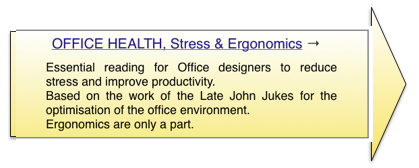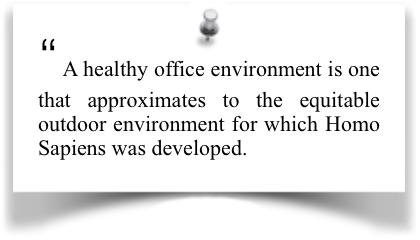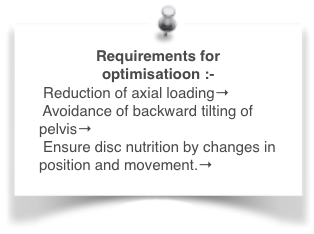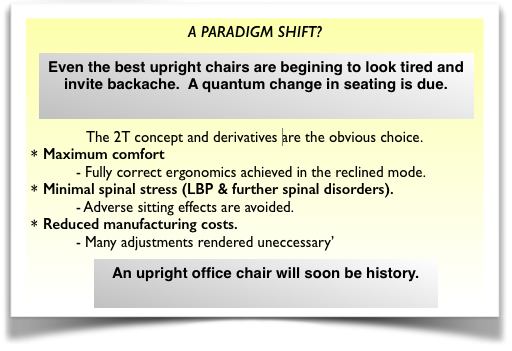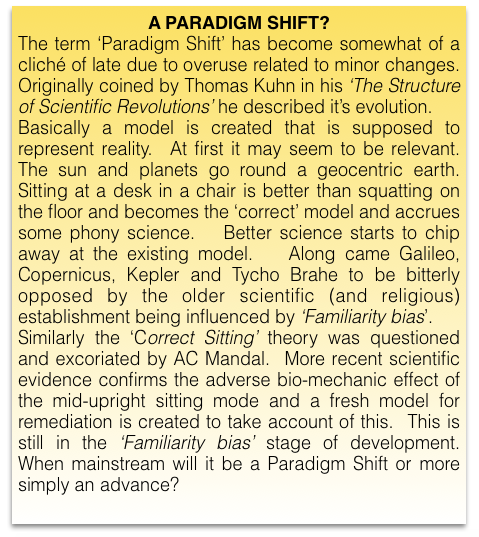Ergonomics of Back-pain. HOW TO SIT FOR PROLONGED WORK
Backache? It does not matter how you sit or on what you sit. What does matter to your spine is how long you sit.
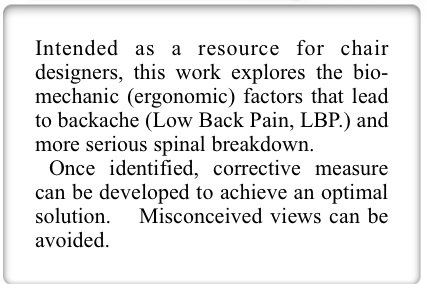 Sitting on a log, a tree stump, an old dining room chair or a conventional office chair does not have a great effect on your back. It is on prolonged sitting that the bio-mechanics (ergonomics) affect spinal components. How long? Research on the ergonomics of Back-pain suggests potential breakdown of spinal components start after 6 hours unless your chair is bio-mechanically friendly to them. This work-time is common in the present work environment. Office chairs are only partially optimised.
Sitting on a log, a tree stump, an old dining room chair or a conventional office chair does not have a great effect on your back. It is on prolonged sitting that the bio-mechanics (ergonomics) affect spinal components. How long? Research on the ergonomics of Back-pain suggests potential breakdown of spinal components start after 6 hours unless your chair is bio-mechanically friendly to them. This work-time is common in the present work environment. Office chairs are only partially optimised.
OBJECT of this work
The incidence of spinal malfunction is becoming greater with the increase in prolonged sitting. This work is intended to explore the bio-mechanical ( ergonomics of Back-pain) factors that may determine spinal pathology and lead to backache (Low Back Pain. LBP). And derive some answers. Essentially medical, it is not intended to be commercial and make a fortune for someone although that is a potential possibility. It simply explains the factors that result in spinal breakdown and how to avoid them through better design. These are derived from ;-
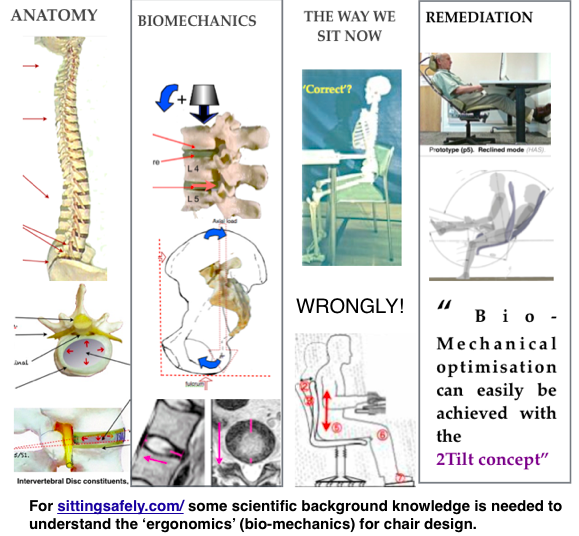 The facts have been available for a number of years, decades even (☛ REMEDIATION).
The facts have been available for a number of years, decades even (☛ REMEDIATION).
However ‘Familiarity bias‘ is strong and millions have suffered from backache as a result.
 Specifically, for general users :-
Specifically, for general users :-
The Ergonomics of Back-pain

The ergonomics of Back-pain→. It results in flexion of the lower lumbar joints, which can cause spinal pathology. 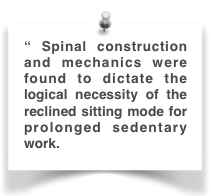 These include permanent stretching of the posterior spinal elements and a shift backwards of the IV disc contents (Smith F, 2007→). towards pain sensitive structures that can account for backache & serious spinal conditions. The upright seated posture.→
These include permanent stretching of the posterior spinal elements and a shift backwards of the IV disc contents (Smith F, 2007→). towards pain sensitive structures that can account for backache & serious spinal conditions. The upright seated posture.→
See ☛ ‘Why?’ Mandal’s Homo sedens→
These adverse effects need to be addressed for effective REMEDIATION →
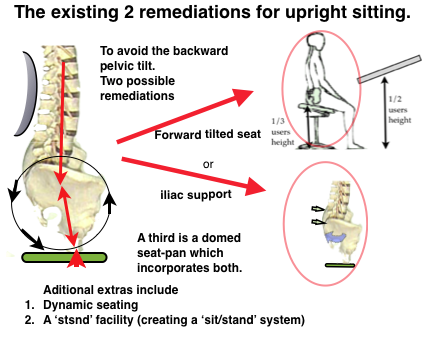
- Derived from these findings are the ergonomic requirements to help remediate the adverse effect of the Upright seated mode.
- Some tips For users and patients (only)
 The 2 TILT (3M) chair CONCEPT.
The 2 TILT (3M) chair CONCEPT.
This is the big story derived from examining the bio-mechanical evidence, identifying the factors which can result in spinal breakdown on upright sitting and finally devising a concept for office work-chair design that avoids these adverse factors. ☛ 2T CONCEPT a full solution
The conclusion was theoretical but was later validated and confirmed by a new 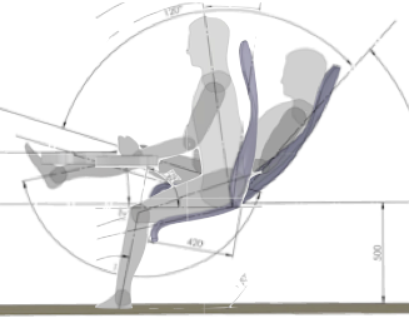 technology ‘positional MRI’ (pMRI). A fully compliant 2T chair is ergonomically optimised (and optimally comfortable). Anything less should be unacceptable for prolonged use. The 2T concept addresses all the ergonomic factors that ensure a sitting position that is the least likely to perpetuate, or
technology ‘positional MRI’ (pMRI). A fully compliant 2T chair is ergonomically optimised (and optimally comfortable). Anything less should be unacceptable for prolonged use. The 2T concept addresses all the ergonomic factors that ensure a sitting position that is the least likely to perpetuate, or 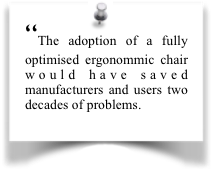 result in, backache and other spinal conditions. It also includes the necessary requirements to make this a user-friendly practical work-chair. Comfort is also thereby maximised. ☛2T CONCEPT a full solution
result in, backache and other spinal conditions. It also includes the necessary requirements to make this a user-friendly practical work-chair. Comfort is also thereby maximised. ☛2T CONCEPT a full solution
Perception & Reality. Familiarity bias
Western people have sat in an upright chair since childhood and have been indoctrinated that mid upright sitting is ergonomically ‘correct’. Although the scientific ergonomics of Back-pain shows the opposite this has resulted in Familiarity bias which has been largely responsible for holding back the new ideas for more apprpriate ergonomic chairs (See in ☛ Familiarity bias.→) It will take time to change this misconceived perception. HAS
A POSTSCRIPT …
There is much advice out there. A lot of it bad! An understading of the scientific bio-mechanical factors described here will enable you to assess how bad. First have a look at what AC Mandal said.  and a number of workchairs are described critically at Various chairs. How do they measure up? The following are mainly trying to sell you something so browse critically …
and a number of workchairs are described critically at Various chairs. How do they measure up? The following are mainly trying to sell you something so browse critically …
- https://www.spine-health.com/wellness/ergonomics/ergonomics-office-and-workplace-overview. Updated in 2006.
- https://www.chairoffice.co.uk/blog/the-ergonomics-of-a-chair-explained/ . OK for advising on the upright sitting mode only. Extract has been used here.
- https://www.posturite.co.uk/blog/8-top-ergonomic-tips-products-fight-back-pain .Good advice, mainly on how to keep moving.
- https://www.everydayhealth.com/back-pain/back-pain-ergonomics.aspx . Peer reviewed by an MD but still simplistic although mentions non sitting causes of spinal dysfunction.
- https://www.spineuniverse.com/wellness/ergonomics/back-pain-prevention-work Chiropractic and herbalist
- https://www.ncbi.nlm.nih.gov/pubmed/1477898 A 1992 review article.
- https://lifesworkpt.com/2016/05/workplace-ergonomics-prevent-back-pain/ A 2016 account.
A digression….
